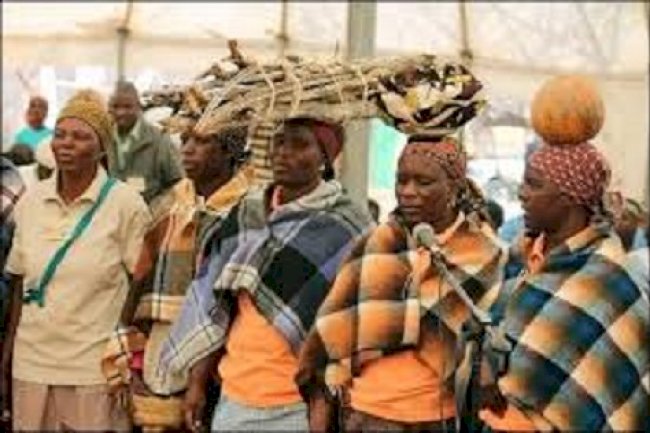Which is the Oldest Civilization in Africa? Part 1
THE OLDEST civilisation in black Africa has been discovered by archaeologists. The kingdom, established more than 5,000 years ago, is nearly 3,000 years older than all previously known black civilisations.

The Origin
The earliest stages of human evolution are believed to have begun in Africa about seven million years ago as a population of African apes evolved into three different species: gorillas, chimpanzees, and humans. Protohumans, as early humans are known, evolved about 2.5 million years ago and had larger brains and stood nearly upright. From prehistoric Africa, humans spread to populate much of the world by 10,000 b.c.e.
The OLDEST civilisation in black Africa has been discovered by archaeologists. The kingdom, established more than 5,000 years ago, is nearly 3,000 years older than all previously known black civilisations.
Archaeologists first found its ruins in and around the modern town of Kerma in the 1920s, but they immediately assumed that it was a distant military outpost of ancient Egypt and remained unaware that an entire city lay beneath the site.
Excavations have unearthed temples, palaces and houses of what is being tentatively identified as the Biblical land of Cush, mentioned in the Book of Genesis in the Hebrew Bible, but misleadingly referred to as Ethiopia in English versions. Noah's grandson was named Cush and some scholars have suggested that the land of Cush took its name from the Biblical character.
Some of the world's first great empires originated in northern Africa around 4000 b.c.e., when Egypt began to develop. As Egyptian society began to decline around 1000 b.c.e., people living further south along the Nile River started building a culturally independent society
After more than 10 years of excavations, archaeologists led by a Swiss professor, Dr Charles Bonnet of Geneva University, are now unearthing the remains of a 200ft- long royal palace in what they believe was the capital of a kingdom almost as big as Egypt itself.
A spectacular temple and the remnants of a 1.5-mile-long city wall, 40ft thick and partially made of fire-baked red bricks, have also been discovered. This is the earliest known systematic use of fired bricks in the world.
It is estimated that the city had a population of between 2,000 and 3,000. Some buildings were thought to be several storeys high, perhaps reaching heights of more than 70ft.
The royal palace, discovered earlier this year, has a 46ft-long throne room with a raised dais at one end. In its nine other rooms, the archaeologists have unearthed dozens of finds including a gold and rock-crystal pendant, most of a 20in-high yellow and red painted male ceramic statue, and hundreds of tiny slabs of clay ready for use as official trading 'stamps'.
The 160ft-long main temple - inside a walled religious complex - was probably dedicated to sun worship. The excavations have now located the central 'holy of holies' linked to a terrace by a 65ft-high stairway.
Professor Bonnet's team has also investigated dozens of tombs - many of them involving human sacrifice. Some individuals were buried with up to a dozen sacrifices, believed to be slaves or family members. The king was buried with more than 400 sacrificed men, women and children.
The kingdom of Cush was finally conquered by Egypt in around 1500BC. Signs of burning from the attack have been found by the archaeologists.
Between 5500 and 3500 BCE, Egypt developed an urban kingdom and became a major power in the Mediterranean. The Nile River made this possible, as predictable floods spread nutrient-rich silt across thousands of acres of farmland, making possible an agricultural surplus of crops like barley and wheat. With plenty of food, and then some, towns developed around markets, where farmers exchanged this surplus for outside goods. Some people accumulated more grain than others, thus creating wealth, and they took control of vast tracts of land beyond their regular family holdings. Over time, they became priests and other high-ranking officials, and built temples as shrines and tombs beginning around 3500 BCE.
The Other Emerging Empires
The Cushite civilisation first began to develop in around 3200BC, grew rapidly after 2400 and reached its peak between 1750 and 1500 BC. At that point it appears to have stretched for 700 miles along the Nile between Aswan in southern Egypt and the Fourth Cataract, 200 miles north of what is now Khartoum.
The heart of the kingdom was a large city, which flourished 300 miles south of ancient Egypt in what is now Sudan. It was founded long before the civilisations of Ethiopia, northern Nigeria and Zimbabwe, which are respectively 2,600, 2,400 and 1,000 years old.
Reference
Internet African History Sourcebook. http://www.fordham.edu/halsall/africa/africasbook.html (accessed on July Halsall, Paul. 31, 2003).
Iliffe, John. Africans: The History of a Continent. New York: Cambridge, 1995.
Villiers, Marq, and Sheila Hirtle. Into Africa: A Journey through the Ancient Empires. Toronto, Canada: Key Porter, 1997.
News > UK, Ancient African kingdom discovered in Sudan, by David Keys
2019 Encyclopedia.com
What's Your Reaction?

























